Grain Size Analyses and Mineral Compositions of Core Sediments in the Western North Pacific Ocean: Implications for the Rare Earth Element and Yttrium Enrichment and Deposition Environment
Abstract
:1. Introduction
2. Materials and Analytical Methods
2.1. Sediment Samples
2.2. Grain Size Analysis
2.3. Geochemical Analyses
2.4. Microscopic Observation
2.5. X-ray Diffraction Analyses (XRD)
3. Results
3.1. Mineral Composition
3.1.1. Smear Slides
- Unit 1, ranging from the surface to approximately 90 cm (Figure 2a–c), is characterized by dominant clay-sized fractions, with minor biogenic components, rock-forming minerals.
- Unit 2, ranging from approximately 100 cm to 340 cm (Figure 2d–f), shares similarities with unit 1. It mainly consists of clay-sized fractions and detritus of rock-forming minerals. However, it exhibits an increasing abundance of Fe/Mn micronodules, fish debris, and sporadic occurrences of phillipsite.
- Unit 3 is phillipsite-rich layers (~350–370 cm) containing large amounts of euhedral phillipsites and moderate amounts of Fe-Mn micronodules and fish debris (Figure 2g–i). The phillipsite grains are relatively large, ranging from approximately 40 to 120 μm. The size of Fe/Mn micronodule grains ranges from approximately 10 to 100 μm.
- Unit 4, the lower section of the core (~380–449 cm) is extremely rich in fish debris, with minor amounts of Fe/Mn micronodules and phillipsites (Figure 2j–l).
3.1.2. Mineral Components in Coarse Fraction
- In the upper part of unit 1 (~0–20 cm), three samples were mainly composed of biogenic components, such as radiolarians (Figure 3a) and sponge spicules (Figure 3b). Although rock-forming detritus was occasionally scattered, there was hardly any presence of Fe/Mn micronodules in these samples. On the contrary, the lower part of unit 1 (~30–90 cm) is characterized by an increasing abundance of Fe/Mn micronodules and rock-forming detritus and by the absence of biogenic components (Figure 3c). In addition, the sporadic distribution of well-conserved fish teeth and fish bone debris was observed in the lower part of unit 1.
- In unit 2 (~100–340 cm), the abundance of Fe/Mn micronodules continuously increased, while rock-forming detritus (such as quartz and feldspar) dramatically decreased with depth. The Fe–Mn micronodules commonly exhibited ellipsoidal and sub-spherical shapes with diameters ranging from 100 to 800 μm. Occasionally, warty-like protrusions were developed on their rough surfaces (Figure 3d–f). On the other hand, biogenic components diminished with the increase in phillipsite, with only the sporadic distribution of fish debris among these samples.
- Unit 3 contained large amounts of phillipsite. Fe–Mn micronodules and phillilpsite are predominant in the coarse fractions. The first layer (~350 cm, Figure 3g) was almost entirely composed of Fe–Mn micronodules with loose crusts. It was determined that almost all micronodules were characterized by sub-parallel growth layers around the nuclei, which usually consisted of detrital minerals such as phillipsite, basalt fragments, or other biological remains [40]. The Fe–Mn micronodules in this unit were strikingly different from those in unit 1 and unit 2, with nuclei mainly composed of phillipsite grains that were either entirely wrapped (data not published yet) or half-wrapped by loose Fe–Mn crust. Hence, Fe–Mn micronodules were dominant, and fish debris and rock-forming detritus were absent in this sample. In contrast, the lower part of this unit (~360–370 cm, Figure 3h,i) was composed of huge amounts of euhedral phillipsites and phillipsite aggregates, with decreased amounts of Fe–Mn micronodules. Interestingly, the amounts of fish debris in the layer at 370 cm (Figure 3i) began to increase compared to all the samples described above.
- Huge amounts of “white fractions” were widely distributed in unit 4 (~380–449 cm). Beyond fish teeth and bone debris, there was a notable presence of numerous small white spheres (Figure 3l) and large loose flakes (Figure 3k). Notably, both white substances were observed to dissolve upon the addition of hydrochloric acid and showed the characteristic peaks of PO43– with the application of microscopical laser Raman spectroscopy (data not published yet). Additionally, peculiar octopussy leg-shaped substances were discovered within this unit, suggesting their probable biogenic origin (Figure 3j). However, the abundance of Fe–Mn micronodules and phillipsites was significantly reduced within this unit. In summary, the composition of this layer, rich in calcium phosphate, exhibited distinct differences compared to the other units described above.
3.1.3. XRD Analysis
3.2. Grain Size Analyses
3.2.1. Grain Distribution Variation in Original Samples and Acidified Samples
3.2.2. Granularity Structure
3.2.3. Grain Size Distribution (GSD)
4. Discussion
4.1. Components Forming the Peaks in the GSDbulk
4.2. Analyses between ΣREY Contents and Grain Size Characteristics
4.3. Implications for the Deposition Environment of REY-Rich Sediments
5. Conclusions
Supplementary Materials
Author Contributions
Funding
Data Availability Statement
Acknowledgments
Conflicts of Interest
References
- Minowa, T. Rare earth meganets: Conservation of energy and the environment. Resour. Geol. 2008, 58, 414–422. [Google Scholar] [CrossRef]
- Gunn, G. Rare earth elements. In Critical Metals Handbook; British Geological Survey: Keyworth, UK, 2014; pp. 312–339. [Google Scholar]
- Alonso, E.; Sherman, A.M.; Wallington, T.J.; Everson, M.P.; Fileld, F.R.; Roth, R.; Kirchain, R.E. Correction to evaluating rare earth element availability: A case with revolutionary demand from clean technologies. Environ. Sci. Technol. 2012, 46, 3406–3414. [Google Scholar] [CrossRef] [PubMed]
- Kato, Y.; Fujinaga, K.; Nakamura, K.; Takaya, Y.; Kitamura, K.; Ohta, J.; Toda, R.; Nakashima, T.; Iwamori, H. Deep-sea mud in the Pacific Ocean as a potential resource for rare-earth elements. Nat. Geosci. 2011, 4, 535–539. [Google Scholar] [CrossRef]
- Jiang, X.D.; Sun, X.M.; Chou, Y.M.; Hein, J.R.; He, G.W.; Fu, Y.; Li, D.-F.; Liao, J.-L.; Ren, J.-B. Geochemistry and origins of carbonate fluorapatite in seamount Fe Mn crusts from the Pacific Ocean. Mar. Geol. 2020, 423, 106135. [Google Scholar] [CrossRef]
- Bi, D.; Shi, X.; Huang, M.; Yu, M.; Zhou, T.; Zhang, Y.; Zhu, A.; Shi, M.; Fang, X. Geochemical and mineralogical characteristics of deep-sea sediments from the western North Pacific Ocean: Constraints on the enrichment processes of rare earth elements. Ore Geol. Rev. 2021, 138, 104318. [Google Scholar] [CrossRef]
- Wang, F.; He, G.; Deng, X.; Yang, Y.; Ren, J. Fish Teeth Sr Isotope Stratigraphy and Nd Isotope Variations: New Insights on REY Enrichments in Deep-Sea Sediments in the Pacific. J. Mar. Sci. Eng. 2021, 9, 1379. [Google Scholar] [CrossRef]
- Yasukawa, K.; Kino, S.; Ohta, J.; Azami, K.; Tanaka, E.; Mimura, K.; Fujinaga, K.; Nakamura, K.; Kato, Y. Stratigraphic Variations of Fe–Mn Micronodules and Implications for the Formation of Extremely REY-Rich Mud in the Western North Pacific Ocean. Minerals 2021, 11, 270. [Google Scholar] [CrossRef]
- Deng, Y.; Guo, Q.; Zhu, J.; He, G.; Yang, Y.; Cao, J.; Ren, J.; Liu, Y.; Famiyeh, L.; Guo, B.; et al. Significant contribution of seamounts to the oceanic rare earth elements budget. Gondwana Res. 2022, 112, 71–81. [Google Scholar] [CrossRef]
- Qiu, Z.; Ma, W.; Tao, C.; Koschinsky, A.; Hu, S. Clay Minerals and Sr-Nd Isotope Compositions of Core CG 1601 in the Northwest Pacific: Implications for Material Source and Rare Earth Elements Enrichments. Minerals 2022, 12, 287. [Google Scholar] [CrossRef]
- Tanaka, E.; Yasukawa, K.; Nakamura, K.; Ohta, J.; Miyazaki, T.; Vaglarov, B.S.; Machida, S.; Fujinaga, K.; Iwamori, H.; Kato, Y. Secular Variations in Provenance of Sedimentary Components in the Western North Pacific Ocean Constrained by Sr Isotopic Features of Deep-Sea Sediments. Geochem. Geophys. Geosyst. 2022, 23, 1. [Google Scholar] [CrossRef]
- Fujinaga, K.; Yasukawa, K.; Nakamura, K.; Machida, S.; Takaya, Y.; Ohta, J.; Araki, S.; Liu, H.; Usami, R.; Maki, R.; et al. Geochemistry of REY-rich mud in the Japanese Exclusive Economic Zone around Minamitorishima Island. Geochem. J. 2016, 50, 575–590. [Google Scholar] [CrossRef]
- Iijima, K.; Yasukawa, K.; Fujinaga, K.; Nakamura, K.; Machida, S.; Takaya, Y.; Ohta, J.; Haraguchi, S.; Nishio, Y.; Usui, Y.; et al. Discovery of extremely REY-rich mud in the western North Pacific Ocean. Geochem. J. 2016, 50, 557–573. [Google Scholar] [CrossRef]
- Shi, X.; Bi, D.; Huang, M.; Yu, M.; Luo, Y.; Zhou, T.; Zhang, Z.; Liu, J. Distribution and metallogenesis of deep-sea rare earth elements. Geol. Bull. China 2021, 40, 195–208. [Google Scholar]
- Toyoda, K.; Tokonami, M. Toyoda Diffusion of rare-earth elements in fish teeth from deepsea sediments. Nature 1990, 345, 607–609. [Google Scholar] [CrossRef]
- Kon, Y.; Hoshino, M.; Sanematsu, K.; Morita, S.; Tsunematsu, M.; Okamoto, N.; Yano, N.; Tanaka, M.; Takagi, T. Geochemical Characteristics of Apatite in Heavy REE-rich Deep-Sea Mud from Minami-Torishima Area, Southeastern Japan. Resour. Geol. 2014, 64, 47–57. [Google Scholar] [CrossRef]
- Yasukawa, K.; Liu, H.; Fujinaga, K.; Machida, S.; Haraguchi, S.; Ishii, T.; Nakamura, K.; Kato, Y. Geochemistry and mineralogy of REY-rich mud in the eastern Indian Ocean. J. Asian Earth Sci. 2014, 93, 25–36. [Google Scholar] [CrossRef]
- Shi, X.; Fu, Y.; Li, B.; Huang, M.; Ren, X.; Liu, J.; Yu, M.; Li, C. Research on Deep sea Minerals in China: Progress and Discovery. Bull. Miner. Petrol. Geochem. 2021, 40, 305–318. [Google Scholar]
- Li, D.; Fu, Y.; Liu, Q.; Reinfelder, J.R.; Hollings, P.; Sun, X.; Tan, C.; Dong, Y.; Ma, W. High-resolution LA-ICP-MS mapping of deep-sea polymetallic micronodules and its implications on element mobility. Gondwana Res. 2020, 81, 461–474. [Google Scholar] [CrossRef]
- Tanaka, E.; Nakamura, K.; Yasukawa, K.; Mimura, K.; Fujinaga, K.; Ohta, J.; Iijima, K.; Nozaki, T.; Machida, S.; Kato, Y. Chemostratigraphic Correlations of Deep-Sea Sediments in the Western North Pacific Ocean: A New Constraint on the Distribution of Mud Highly Enriched in Rare-Earth Elements. Minerals 2020, 10, 575. [Google Scholar] [CrossRef]
- Yu, M.; Shi, X.; Huang, M.; Liu, J.; Yan, Q.; Yang, G.; Li, C.; Yang, B.; Zhou, T.; Bi, D.; et al. The transfer of rare earth elements during early diagenesis in REY-rich sediments: An example from the Central Indian Ocean Basin. Ore Geol. Rev. 2021, 136, 104269. [Google Scholar] [CrossRef]
- Zhou, T.; Shi, X.; Huang, M.; Yu, M.; Bi, D.; Ren, X.; Liu, J.; Zhu, A.; Fang, X.; Shi, M. Genesis of REY-rich deep-sea sediments in the Tiki Basin, eastern South Pacific Ocean: Evidence from geochemistry, mineralogy and isotope systematics. Ore Geol. Rev. 2021, 138, 104330. [Google Scholar] [CrossRef]
- Ren, J.; Jiang, X.; He, G.; Wang, F.; Yang, T.; Luo, S.; Deng, Y.; Zhou, J.; Deng, X.; Yao, H.; et al. Enrichment and sources of REY in phosphate fractions: Constraints from the leaching of REY-rich deep-sea sediments. Geochim. Cosmochim. Acta 2022, 335, 155–168. [Google Scholar] [CrossRef]
- Ohta, J.; Yasukawa, K.; Machida, S.; Fujinaga, K.; Nakamura, K.; Takaya, Y.; Iijima, K.; Suzuki, K.; Kato, Y. Geological factors responsible for REY-rich mud in the western North Pacific Ocean: Implications from mineralogy and grain size distributions. Geochem. J. 2016, 50, 591–603. [Google Scholar] [CrossRef]
- Zhang, X.; Lu, Y.; Miao, Y.; Huang, M.; Zhu, K.; Cai, L.; Wang, J.; Shi, X. Radiogenic Nd in bioapatite from rare earth elements rich deep sea sediments from Central Indian Oceanic Basin and its implication in material sources. Ore Geol. Rev. 2023, 154, 105295. [Google Scholar] [CrossRef]
- Kashiwabara, T.; Toda, R.; Fujinaga, K.; Honma, T.; Takahashi, Y.; Kato, Y. Determination of Host Phase of Lanthanum in Deep-sea REY-rich Mud by XAFS and µ-XRF Using High-energy Synchrotron Radiation. Chem. Lett. 2014, 43, 199–200. [Google Scholar] [CrossRef]
- Takaya, Y.; Yasukawa, K.; Kawasaki, T.; Fujinaga, K.; Ohta, J.; Usui, Y.; Nakamura, K.; Kimura, J.-I.; Chang, Q.; Hamada, M.; et al. The tremendous potential of deep-sea mud as a source of rare-earth elements. Sci. Rep. 2018, 8, 5763. [Google Scholar] [CrossRef]
- Mamurtry, G.; Yeh, H.-W. Hydrothermal clay mineral formation of East Pacific Rise and Bauer Basin sediments. Chem. Geol. 1981, 32, 189–205. [Google Scholar] [CrossRef]
- Dubinin, A.V.; Svalnov, V.N. Geochemistry of rare earth elements in ferromanganese micro- and macronodules from the Pacific nonproductive zone. Lithol. Miner. Res. 2000, 35, 520–537. [Google Scholar] [CrossRef]
- Liu, J.; Liang, H.; Xia, N.; Song, S. REE geochemistry of <2 μm fractions in deep-sea sediments from East Pacific. Geochemistry 1998, 27, 49–58. [Google Scholar]
- Liu, Y.; Jing, Y.; Zhao, W. Distribution of rare earth elements and implication for Ce anomalies in the clay-sized minerals of deep-sea sediment, Western Pacific Ocean. Appl. Clay Sci. 2023, 235, 106876. [Google Scholar] [CrossRef]
- Hu, Q.; Li, C.; Yang, B.; Fang, X.; Lv, H.; Shi, X.; Liu, J. Clay mineral distribution characteristics of surface sediments in the South Mid-Atlantic Ridge. J. Oceanol. Limnol. 2023, 41, 897–908. [Google Scholar] [CrossRef]
- Liao, J.; Sun, X.; Wu, Z.; Sa, R.; Guan, Y.; Lu, Y.; Li, D.; Liu, Y.; Deng, Y.; Pan, Y. Fe-Mn (oxyhydr)oxides as an indicator of REY enrichment in deep-sea sediments from the central North Pacific. Ore Geol. Rev. 2019, 112, 103044. [Google Scholar] [CrossRef]
- Lv, W.; Yi, L.; Fu, T.; Yang, J.; Chen, G.; Lin, Z.; Xu, X.; Yu, H. Grain-size characteristics and environmental significance of abyssal sediments from the southwest Indian Ridge. Adv. Mar. Sci. 2017, 35, 512–523. (In Chinese) [Google Scholar]
- Sa, R.; Sun, X.; He, G.; Xu, L.; Pan, Q.; Liao, J.; Zhu, K.; Deng, X. Enrichment of rare earth elements in siliceous sediments under slow deposition: A case study of the central North Pacific. Ore Geol. Rev. 2018, 94, 12–23. [Google Scholar] [CrossRef]
- Wei, X.; Shi, X.; Xu, Y.; Castillo, P.R.; Zhang, Y.; Zhang, L.; Zhang, H. Mid-Cretaceous Wake seamounts in NW Pacific originate from secondary mantle plumes with Arago hotspot composition. Chem. Geol. 2022, 587, 120632. [Google Scholar] [CrossRef]
- Hu, R.; Piotrowski, A.M. Neodymium isotope evidence for glacial-interglacial variability of deepwater transit time in the Pacific Ocean. Nat. Commun. 2018, 9, 4709. [Google Scholar] [CrossRef]
- Plank, T.; Ludden, J.N.; Escutia, C.; Party, S.S. Leg 185 summary: Inputs to the Izu–Mariana subduction system. In Ocean Drilling Program Proceedings, Initial Reports; Ocean Drilling Program: College Station, TX, USA, 2000; Volume 185, pp. 1–63. [Google Scholar]
- Takaya, Y.; Fujinaga, K.; Yamagata, N.; Araki, S.; Maki, R.; Nakamura, K.; Iijima, K.; Kato, Y. Chemical leaching of rare earth elements from highly REY-rich mud. Geochem. J. 2015, 49, 637–652. [Google Scholar] [CrossRef]
- Liao, J.; Sun, X.; Li, D.; Sa, R.; Lu, Y.; Lin, Z.; Xu, L.; Zhan, R.; Pan, Y.; Xu, H. New insights into nanostructure and geochemistry of bioapatite in REE-rich deep-sea sediments: LA-ICP-MS, TEM, and Z-contrast imaging studies. Chem. Geol. 2019, 512, 58–68. [Google Scholar] [CrossRef]
- Folk, R.L.; Andrews, P.B.; Lewis, D.W. Detrital sedimentary rock classification and nomenclature for use in New Zealand. N. Z. J. Geol. Geophys. 1970, 13, 937–968. [Google Scholar] [CrossRef]
- Takebe, M. Carriers of Rare Earth Elements in Pacific Deep-Sea Sediments. J. Geol. 2005, 113, 201–215. [Google Scholar] [CrossRef]
- Trueman, C.N.; Tuross, N. Trace Elements in Recent and Fossil Bone Apatite. Rev. Mineral. Geochem. 2002, 48, 489–521. [Google Scholar] [CrossRef]
- Nemliher, J.G.; Baturin, G.N.; Kallaste, T.E.; Murdmaa, I.O. Transformation of Hydroxyapatite of Bone Phosphate from the Ocean Bottom during Fossilization. Lithol. Miner. Resour. 2004, 39, 468–479. [Google Scholar] [CrossRef]
- Ohta, J.; Yasukawa, K.; Nozaki, T.; Takaya, Y.; Mimura, K.; Fujinaga, K.; Nakamura, K.; Usui, Y.; Kimura, J.-I.; Chang, Q.; et al. Fish proliferation and rare-earth deposition by topographically induced upwelling at the late Eocene cooling event. Sci. Rep. 2020, 10, 9896. [Google Scholar] [CrossRef] [PubMed]
- Ijiri, A.; Okamura, K.; Ohta, J.; Nishio, Y.; Hamada, Y.; Iijima, K.; Inagaki, F. Uptake of porewater phosphate by REY-rich mud in the western North Pacific Ocean. Geochem. J. 2018, 52, 373–378. [Google Scholar] [CrossRef]
- Nozaki, Y. Rare earth element and their isotopes in the ocean. In Encyclopedia of Ocean Science; Steele, J.H., Thorpe, S.A., Eds.; Academic Press: London, UK, 2001; pp. 2354–2366. [Google Scholar]
- Glaccum, R.; Bostrom, K. Na, K-phillipsite: Its stability conditions and geochemical role in the deep sea. Mar. Geol. 1976, 21, 47–58. [Google Scholar] [CrossRef]
- Deng, Y.; Guo, Q.; Liu, C.; He, G.; Cao, J.; Liao, J.; Liu, C.; Wang, H.; Zhou, J.; Liu, Y.; et al. Early diagenetic control on the enrichment and fractionation of rare earth elements in deep-sea sediments. Gondwana Res. 2022, 8, eabn5466. [Google Scholar] [CrossRef]

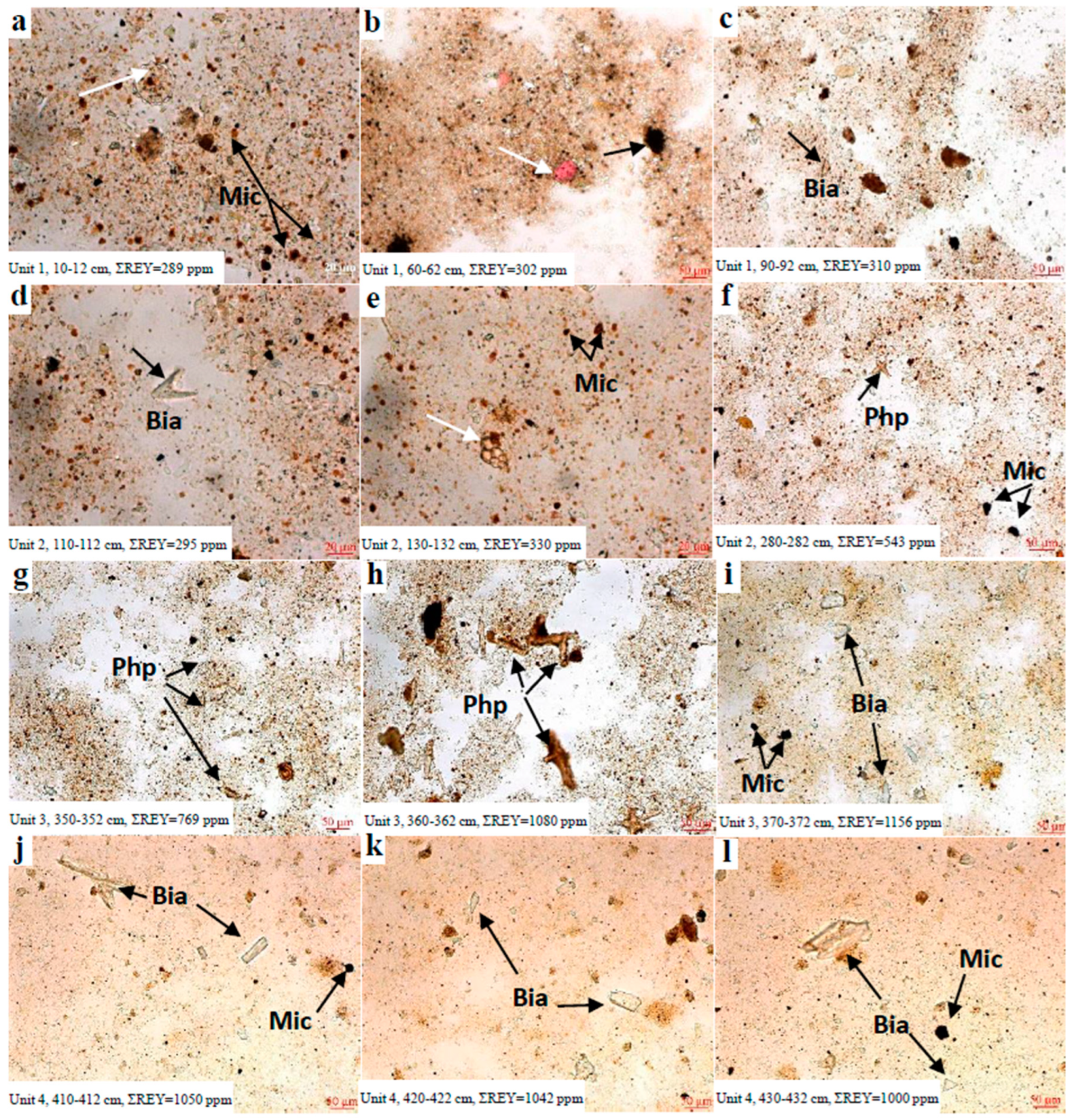
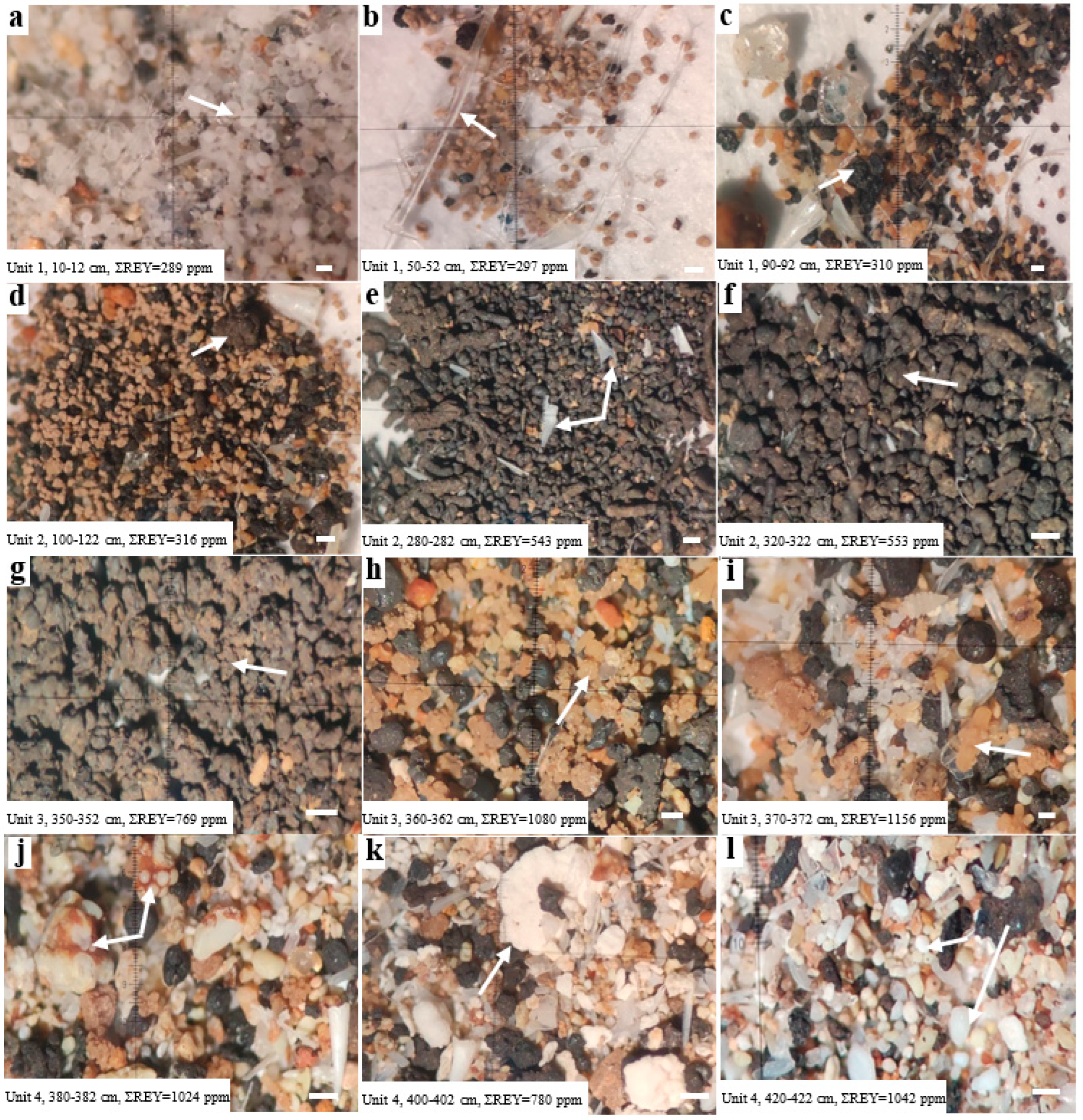
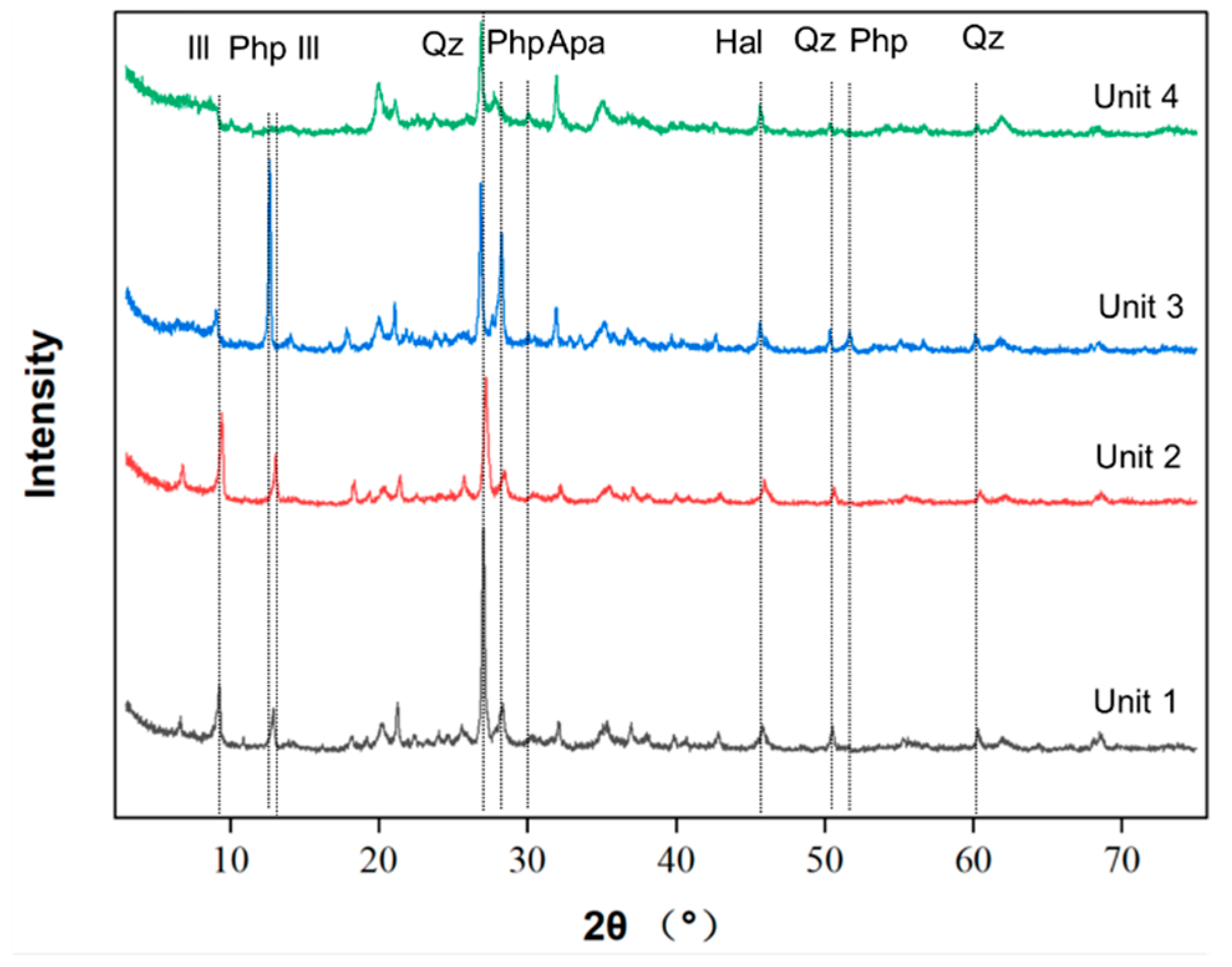

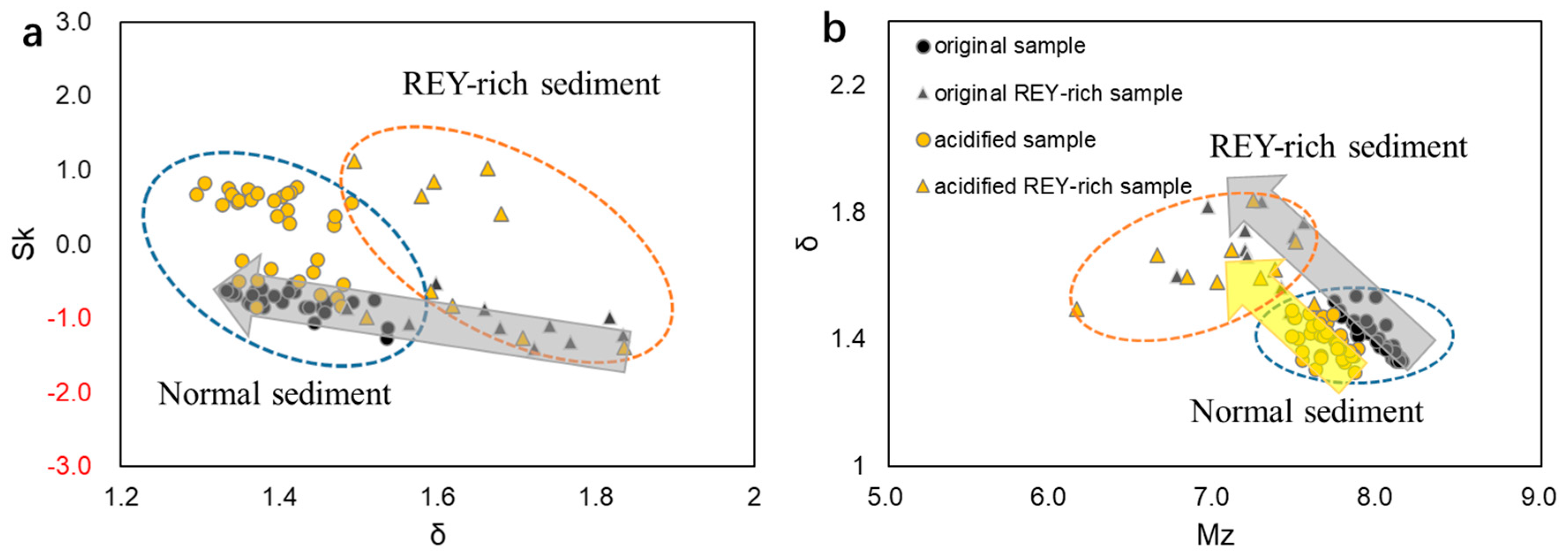
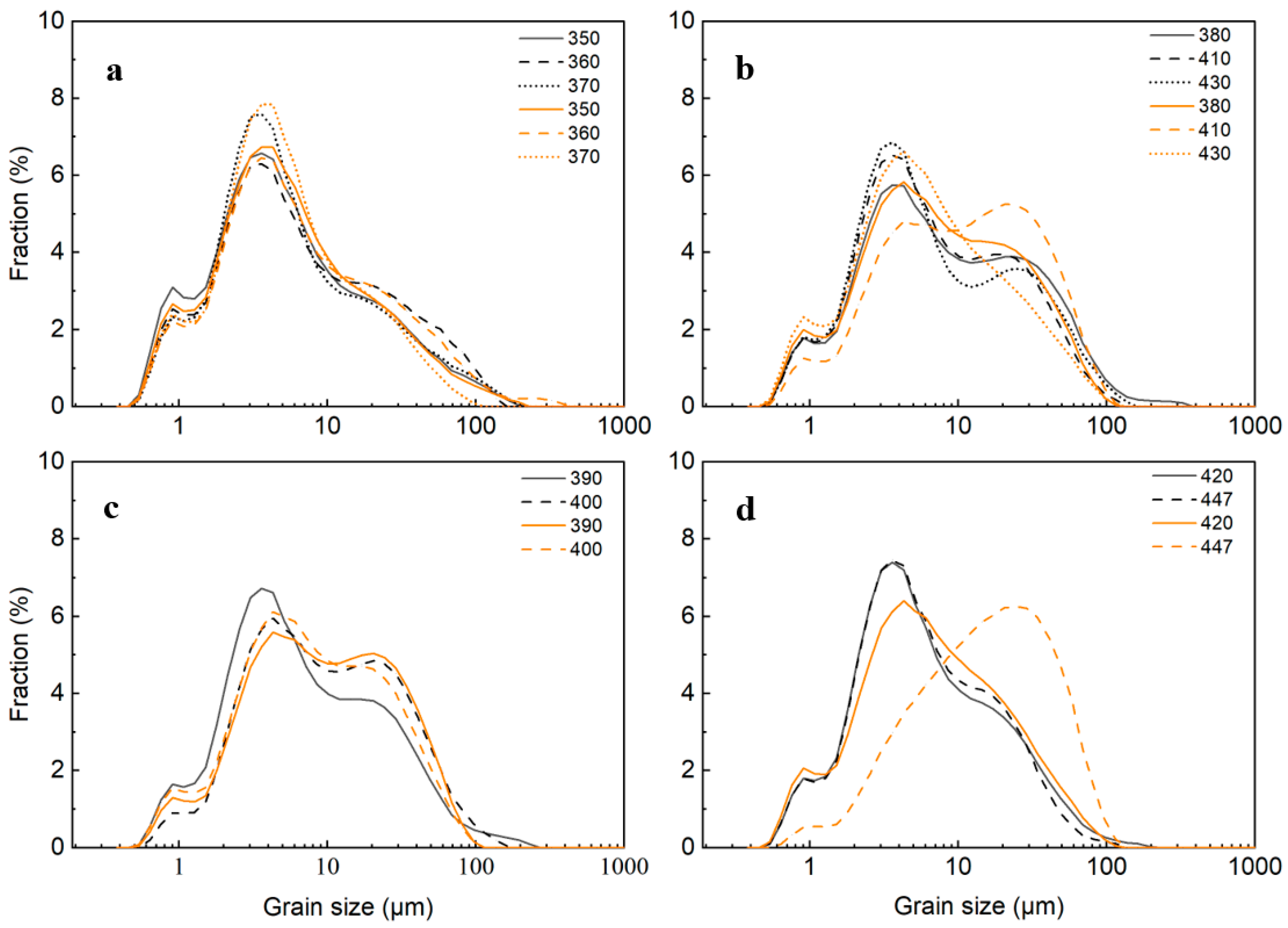
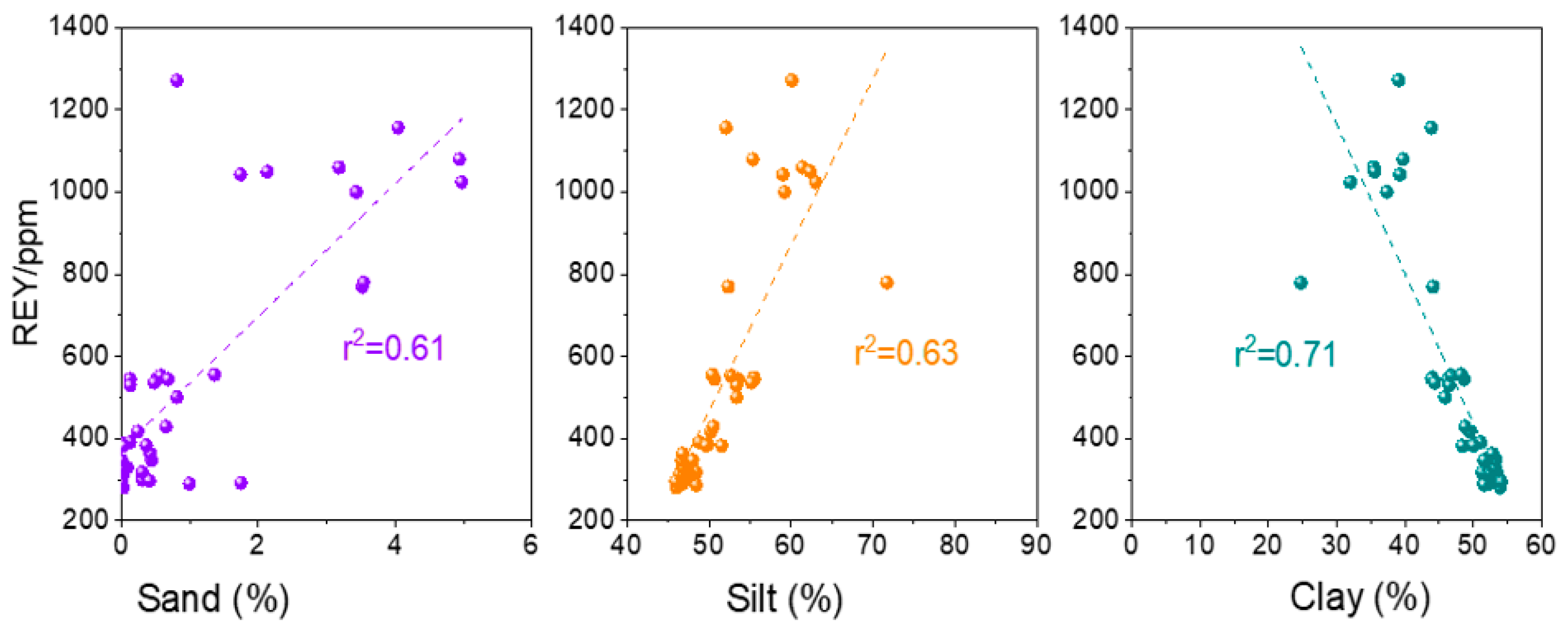
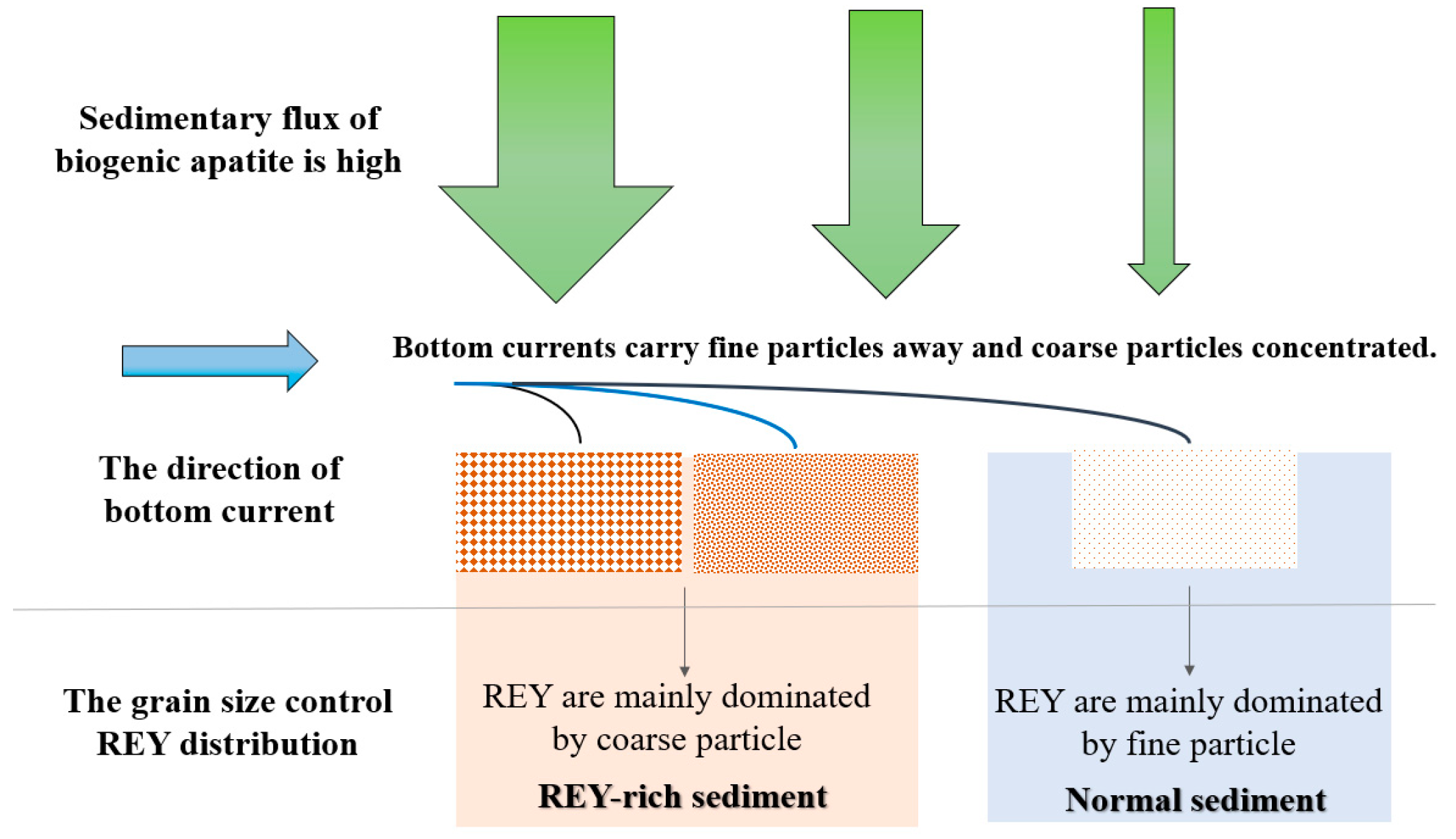
Disclaimer/Publisher’s Note: The statements, opinions and data contained in all publications are solely those of the individual author(s) and contributor(s) and not of MDPI and/or the editor(s). MDPI and/or the editor(s) disclaim responsibility for any injury to people or property resulting from any ideas, methods, instructions or products referred to in the content. |
© 2023 by the authors. Licensee MDPI, Basel, Switzerland. This article is an open access article distributed under the terms and conditions of the Creative Commons Attribution (CC BY) license (https://creativecommons.org/licenses/by/4.0/).
Share and Cite
Hu, Q.; Yu, M.; Bi, D.; Liu, J.; Huang, M.; Zhu, A.; Song, Z.; Shi, X. Grain Size Analyses and Mineral Compositions of Core Sediments in the Western North Pacific Ocean: Implications for the Rare Earth Element and Yttrium Enrichment and Deposition Environment. Minerals 2023, 13, 1470. https://doi.org/10.3390/min13121470
Hu Q, Yu M, Bi D, Liu J, Huang M, Zhu A, Song Z, Shi X. Grain Size Analyses and Mineral Compositions of Core Sediments in the Western North Pacific Ocean: Implications for the Rare Earth Element and Yttrium Enrichment and Deposition Environment. Minerals. 2023; 13(12):1470. https://doi.org/10.3390/min13121470
Chicago/Turabian StyleHu, Qiannan, Miao Yu, Dongjie Bi, Jihua Liu, Mu Huang, Aimei Zhu, Zhaojun Song, and Xuefa Shi. 2023. "Grain Size Analyses and Mineral Compositions of Core Sediments in the Western North Pacific Ocean: Implications for the Rare Earth Element and Yttrium Enrichment and Deposition Environment" Minerals 13, no. 12: 1470. https://doi.org/10.3390/min13121470




